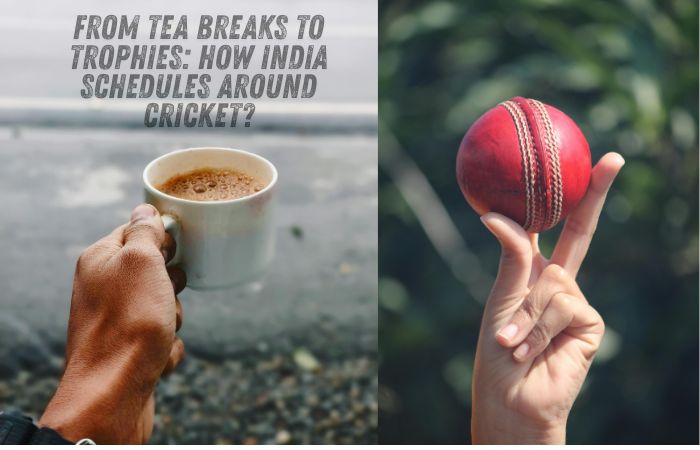Across cities and small towns, the day quietly pivots around first ball and stumps. Tea goes on a few minutes early so everyone can settle in; commute routes are chosen for better signal; errands slide to the drinks break. Office chatter shifts to required rate and form, while shop TVs glow in doorways so passersby can steal a look at the chase. Even chores adapt-pressure cooker hisses during a strategic timeout, dinner plates arrive between overs, and bedtime drifts if a finish looks dramatic. The schedule isn’t written on a calendar; it’s felt in the room when a notification buzzes and the collective heartbeat picks up.
Table of Contents
Screens at Work Home and Everywhere
Cricket now lives wherever a screen can sit. In offices, one desk keeps the live score while others sneak glances at short replays; on trains, audio commentary carries the mood when video drops; at home, TV hosts the big moments while phones handle memes, polls, and group chats. Somewhere inside that rhythm-when a friend asks how to catch desi cricket live without missing the turning, the answer slips in mid-conversation with a quick tap on desi cricket live, and the chat rolls on. The flow is simple: a highlight to bridge a meeting, a live stream for the sofa, a recap before bed. Different screens, same heartbeat, all tuned to the next ball.
Where the game fits into daily screens:
- Workspaces: muted streams tucked in browser tabs, instant GIFs in team chats, shared glances when a wicket falls.
- Homes: TVs for family viewing, phones for parallel commentary, tablets on the kitchen counter for mid-meal updates.
- Public places: tea stalls with loud radios, cafés showing replays between songs, commuters huddled around one device.
- Travel: earphones carrying commentary over the noise of a train or plane, notifications flashing even in airplane mode.
The reach of the game is no longer measured by stadium capacity but by the glow of screens lighting up wherever people pause. Whether it’s a quick break in a cubicle or a long night with family sprawled on cushions, cricket adjusts to every pocket of life. It has become the country’s background rhythm-steady, familiar, and always within reach.
Festivals, Exams, and Fixtures
Big matches don’t just land on the calendar-they rearrange it. Families plan festival visits with an eye on start times, bargaining for “one hour before aarti” or “after the second innings.” Schools nudge mock tests to mornings; coaching centers wrap early on marquee evenings. Offices slide stand-ups or keep a scoreboard tab open in the meeting room so no one pretends not to check.
Shops pull crowds with a TV near the counter, cafés run “last-over” offers, and delivery peaks shift by the run rate. The overlap feels natural because cricket carries the same social gravity as a holiday: it’s a reason to gather, chant a familiar line, and promise a reunion at the next fixture. Even when schedules clash-exam week, quarter-end, temple the compromise is simple: highlights now, live for the finish, and a replay with dessert.
Together Apart: The New Watch Party
The new stand is a patchwork of rooms, rooftops, and chats stitched together by timing. One friend hosts the TV, another calls the sync-“play on three”-and a cousin joins from a hostel with headphones and low light. Reactions stack in real time: a volley of stickers after a boundary, quick polls during reviews, voice notes that land exactly as the replay rolls.
Quiet watch modes keep cafés and balconies considerate; casting lets a living room expand without turning into chaos. When the network dips, audio carries the moment, so the chorus never breaks. What used to need one address and a couch now needs only a link and a time, yet the feeling is the same: a shared beat, the same gasp, and the soft exhale when the chase is done.
Own Rituals
When the last ball lands, the day doesn’t snap shut-it exhales. Plates come out, someone rewinds the turning over, and the group chat fills with time-stamped links, homemade edits, and gentle bragging from fantasy-league winners. Parents ask for “that boundary again,” cousins trade memes until the emojis run out, and a friend on night shift catches up with a bite-sized recap before clocking in.
The next day, you pick up the thread without effort, jump to the parts that matter on a commute, catch a quick recap over lunch, and float a plan for the next watch-together. That’s why cricket keeps a spot on the calendar: less a fixed two-hour block, more a line that runs through meals, meetups, and the small moments you share with friends and coworkers.
Office chatter swaps weekend plans for strike rates and field changes; a teacher sneaks a smile when a student hums last night’s theme; shopkeepers prop a phone near the register so regulars can rewatch the winning shot between customers. Even when the result stings, the conversation softens it-“we were two balls away,” “that catch next time”-and the story stretches just far enough to hold everyone until the evening’s first notification buzzes again.
After the Final Over
Then comes the quiet prep for what’s next. Friends nudge calendars to make room for the rematch, families agree on who brings snacks, and playlists get updated with fresh anthem edits. Someone promises a rooftop screen, someone else sorts a backup hotspot, and the cousin abroad checks time zones to join the sync on cue. By the time the toss arrives, the logistics are already solved. All that’s left is the familiar loop: gather, watch, react, and add one more night to the running list of games that felt bigger than the scoreboard.

